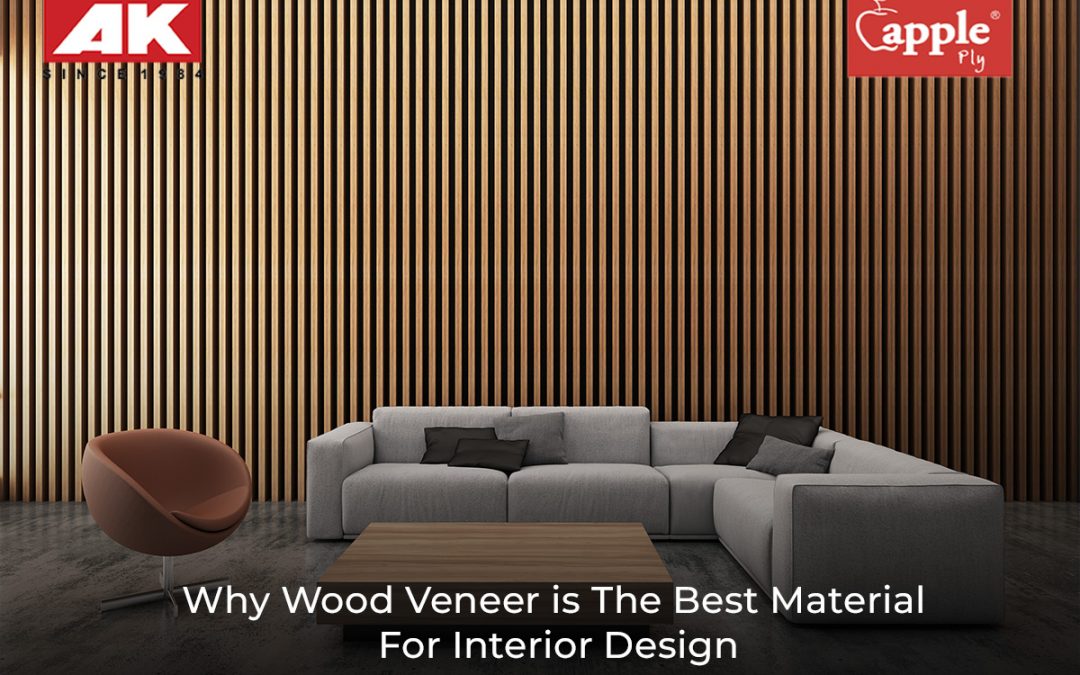Have you always been wanting to give your home a touch of elegance without spending a fortune? You can now embrace the timeless elegance and warmth of wood in your home’s surroundings in a cost-effective manner. Wood veneer interior design should be your go-to interior preference to give your home the perfect finishing touch and an affordable solution that never compromises on quality.
What is Wood Veneer?
Wood veneers are the perfect blend of beauty and practicality, adding a touch of elegance to natural wood in its remarkably thin form.
It’s typically less than 1/40 inch and these slices of actual wood are attached to the thicker base materials like plywood, particle board and MDF to create strong and durable panels. These veneers retain the authentic look without producing much waste due to the advanced machinery used to make them.
They come in various cuts, ranging from plain sawn, quarter sawn, rift cut or rotary cut, and offer a wide option of grain patterns that make interiors look more visually appealing. Moreover, man-made or engineered wood veneers, the alternative to exotic veneers, are crafted from sustainable wood fiber that perfectly replicates the costly woods, offering an eco-friendly and affordable option for all.
What makes wood veneer the Best Interior Design Material?
1. Aesthetic Appeal:
- Natural beauty: Wood veneers offer the rich look of real wood, which adds a luxurious and sophisticated feel to interiors.
- Variety: They come in variety of types in terms of colors, grain, and patterns, allowing for endless customization possibilities.
2. Cost effective design:
- Affordable luxury: Veneers give a luxury feel to the interiors without having to spend a huge amount like in the case of solid wood.
- Resource optimization: Using veneers maximizes the use of a single log, producing more material with less waste being generated.
3. Versatility:
- Flexibility: Veneers can be applied to various surfaces, from furniture, wall panels, and cabinets to doors, improving the aesthetic appeal of the overall space.
- Ease of manipulation: They can be easily cut into different shapes to accommodate any surface, and help achieve detailed design and finishing.
4. Environmental Sustainability:
- Resource efficiency: Since veneers use thin slices of wood, they reduce the amount of timber required, promoting a practice of sustainable design.
- Environmental friendly option: Many veneers are made from sustainably sourced woods, making it the most preferred option for eco-friendly enthusiasts.
5. Durability and Stability:
- Dimensional stability: Veneers are often applied on stable surfaces. This means there’s less risk of warping like in the case of solid wood
- Long lasting finish: It’s a misconception that veneers are not durable. If properly finished and maintained, veneers can be highly durable.
6. Consistency and Uniformity:
- Uniform appearance: Veneers can provide a consistent look without bumps or ridges in comparison to solid wood. This feature helps achieve a seamless design
- Controlled quality: They provide a uniform look because of the liberty to select the right color and pattern across different surfaces.
7. Innovation in Design:
- Advanced techniques: Modern veneering techniques help create complex and innovative designs that would be hard to achieve with solid wood.
- Mixed media: Veneers can be combined with other materials such as metal, glass or fabric to create contemporary designs that go hand in hand with the modern interior design trends.
Veneers and their appeal on different surfaces:
1. Walnut veneer for dining tables:
A walnut veneer applied to a dining table brings out the rich and dark tones of the wood, adding a sense of luxury and sophistication to a space where you enjoy your gourmet meal.
2. Cherry veneer for bedrooms:
A bedroom set made with cherry veneer can provide the much needed warmth and a flavor of elegance without having to invest a huge amount on solid cherry wood furniture.
3. Maple veneer for office desks:
By using maple veneers on office desks, manufacturers can produce many desks from just a single log, maximizing material use while simultaneously minimizing waste.
4. Teak veneer for living rooms:
Teak veneers can be applied to wall panels in a living room, giving the room an attractive appeal with its unique golden-brown color and straight grain patterns.
5. Bamboo veneers for flooring projects:
Using bamboo veneer on flooring projects reduces the need for excessive timber compared to solid bamboo planks, promoting sustainable design practices.
To discover more veneers and understand their suitability on different surfaces and rooms, check out AK Apple Ply and explore a range of high-quality and unique veneers.
Choosing the best wood veneers is made easy with AK Apple Ply
In conclusion, wood veneers emerge as an exceptional option for interior design, seamlessly combining elegance with practicality and creating the most stunning luxury interiors.
As you consider improving your living space, AK Apple Ply’s wood veneers stand out as the perfect choice. Visit AK Apple Ply today and check out the various veneer options lined up to achieve your dream interior design.
FAQs:
1. What is veneer in interior design?
Veneer refers to thin layers of wood applied to all kinds of surfaces, such as furniture, cabinets, doors, etc. These veneers come in various colors and patterns, proving to be an ideal choice in interior design.
2. Is wood veneer waterproof?
Veneers need regular maintenance as they are not waterproof and may get spoilt due to heat. Therefore, veneer finishes are not preferred in moisture-prone areas like kitchens or bathrooms because moisture can easily seep through veneers, making their top layer loose.
3. Is veneer better than wood?
Yes, it’s comparatively better than solid wood. It doesn’t shrink and swell like solid wood, it’s a lot cheaper to purchase and more sustainable as well. Moreover, you can create a uniform look with veneers but not with solid wood.
4. Is veneer fake wood?
Wood veneer is not fake wood. It is a thin piece of natural wood glued to a panel that is made of materials like fibreboards (MDF or HDF). This combination allows veneers to provide an aesthetic appeal to plain solid wood while being economical and sustainable.




